The creation of this site was overseen by Professor Philip Rigg with the grateful assistance of Dr. Jean-Jacques Cory, L'École de l'Architecture, Paris. Professor Cory's assistance was crucial, and the research and the arrangement of this site has been a pursuit of keen interest to us both. I also thank the Estate of Thomas Knowlton--acclaimed Canadian Colon Scholar--for its support. Although the extremely liberal, near-scandalous "interpretations" of the CSAC Letters by the revisionist Colon scholar, Michael Peters, are questionable, I would appear negligent to forego acknowledging certain results of his "research" to date.
--Philip Rigg
Portions of the following texts were translated from the French by David Schwarz. Web Design by Angelique Aussi. Last updated February 17, 1996.
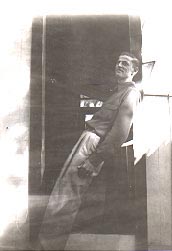
![]() FLEURY
FLEURY
COLON
Fleury Colon (Regarder Plus) in the doorway of MÉM 3.
As we near the end of this century, I have noticed a delicate resurgence of interest in the life and work of Fleury Colon. The trajectory of his life is nothing short of breathtaking: metallurgist, architect, engineer, draftsman, mathematician, and finally, rocket scientist, all the while employing his gifts as poet and artist. There is no figure quite like Fleury Colon in the whole of the 20th century. And in an age of specialization and over-classification, in an age when artists and thinkers are forced into the cage of their disciplines, it seems appropriate to recognize Colon as a visionary who transcended the limitations of modernity.
When Colon's name is mentioned within the architectural community, the typical response is a smirk of amused curiosity. But within the scientific community, the name "Fleury Colon" meets with quizzical indifference, consternation, and even more commonly, absolute astonishment. Regardless, ignorance within every academic discipline is the norm. Why does Colon's existence remain so veiled? A recent development might see Colon's archived work placed in an esteemed university's special collections library; but in a more broad sense of the matter, the Academy continues to overlook Fleury Colon. Why? What are we missing? What will we glean from a fuller understanding of his creations and his vision of utopia?
Fleury Colon's incredible, yet ignored feats were accomplished through an amazing sequence of events. His stunning yet tragic story must be told. While I'm completing a more comprehensive Colon biography, it's my hope this Website will serve as the foundation for further, more detailed investigations. I want to shed light on the romantic spirit of Fleury Colon. I hope to burn off the veil of fog--the indifference and the ignorance--and bring this strange figure, if for a brief moment, to the fore of The Academy. Finally, as a Canadian, I hope to assemble the existing shards of Colon's story into a Canadian perspective, and thus, secure Colon's place within world history.
Now, with the sudden popularity and stunning potential of the World Wide Web, everyone everywhere will have access to details that will unveil Colon's existence to academia. Although all previously published studies of Colon's works are out of print and difficult to find, this Website exhibits a stunning arrangement of facts that have not been available to the public for at least 22 years. Existing details of Colon's life have been chronologically arranged into "web chapters." Some areas are more detailed, depending on the amount of information available. I sincerely apologize for any omissions, truncations or errors. Until my research is complete, this makeshift site must serve as a temporary springboard for accumulating knowledge.
1. A QUICK OVERVIEW WITH OBSCURE POINTS OF REFERENCE
2. BIRTH OF THE ENIGMA & THE FORMATIVE YEARS
3. AN INTERDISCIPLINARY EDUCATION & ANARCHICAL LOVE
5. POST-WAR PARIS & AN AFFAIR WITH LETTRISM
9. THE MADNESS OF FLEURY COLON
11.
THE LEGACY OF FLEURY COLON
1. A QUICK OVERVIEW WITH OBSCURE POINTS OF REFERENCE
Fleury Colon's infatuation with the "épi" or "finial" as the ultimate architectural shape brings him, perhaps, the most notoriety. To explain this architectural shape, the épi or finial is a foliated ornament in Gothic or Victorian architecture that forms a decorative, crowning detail. Ornamental in nature, it is directly related to the French architectural tradition. Hence, these architectural shapes are found all over the world due to the French Colonial presence in the preceding centuries.
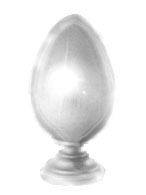
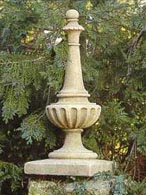
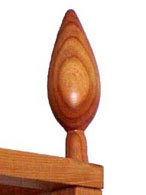
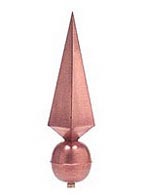
Images of standard finial or épi shapes.
It was this form--the "épi" or "finial"--that became Colon's lifelong obsession; but this is usually the point where general knowledge of Colon's existence begins to elude us. Any information following the fact of Colon's finial fixation eludes all conscious and unconscious spheres of the general public.
If he is known in limited circles as the obscure French architect who was obsessed with the finial, he is known even less for his brief association with the Avant-Garde movement of Lettrism. Much less is known about Colon's break with the Lettristes, and in turn, even less is known about the specifics of this break, which occurred before his departure for Canada.
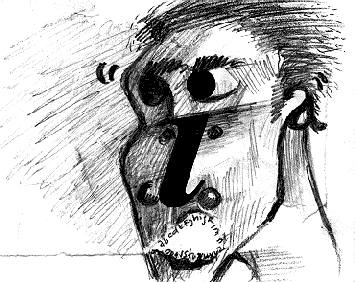
Lettriste self-portrait/auto-portrait, c.1948; courtesy Knowlton Estate (Colon Archive).
But to say Fleury Colon is "known" for anything seems to contradict his strange ahistorical existence. It only follows that his breathtaking achievements in the forests north of Montréal remain almost unmentioned, as if they never occurred. There is no doubt that the second half of his career has been overlooked, even neglected. In fact, so little is known about this equally stunning period--arguably his most creative period--that the task of research seems daunting.
Certainly his concealment in the Canadian forest, literally and figuratively, accounts for a large amount of confusion and the lack of documentation. There is the additional fact that Colon operated outside "the institution" that was working outside The Institution. In short, he was out avant-garding the Avant-Garde. Because of his abrupt departure from both Lettrism and France, it's conceivable that a backlash developed that originated from inside the avant-garde itself. This may explain some of the bitter statements and perspectives of those peripherally associated with Colon in the period between World War II and his departure for Canada.
"Téte de con (Colon), that raving madman. I'm sure the imbecile is naked in the Canadian wilderness. I'm sure he is living off the land, eating locusts, honey, and beaver. I can see him barking out his self-righteous sermons to a forest of trees. He is probably baptizing the animals of the forest. But I don't want his head! I rejoice at his departure. Let Canada have him, the fools."
--Jean-Robert Champlain, Lettriste, excerpted from Champlain's journal.
It's possible that rash and subjective statements such as these have colored Colon's legitimacy among Continental scholars. There is the additional problem of sorting through the politics of the Lettriste Movement, more specifically, the disputed and unsolved accusation that Colon was scandalously involved with the Vichy Government when he submitted architectural designs of train station shelters shaped like finials. To his credit, Colon disputes the accusations of "Champlain and his henchmen" at every conceivable opportunity.
Perhaps the precedence set by Ezra Pound and Martin Heidegger--for cavorting with fascism--coaxed lazy academics to rush prematurely to Colon's judgment. It's likely that Colon's case was dismissed with too much haste, not to mention too little research. Other than self-published journals and brash manifestos, most Avant-Garde movements coming out of the Second World War practiced little documentation of their undertakings. This environment would certainly encourage wild inaccuracies that would leave The Academy scratching its figurative head.
Additionally, there is the Avant-Garde's practice of inflating the significance of their activities. A quick response of righteousness or "political correctness" from either camp may account for the mystery of this unsolved scandal, namely Colon's alleged intention to collaborate with the Vichy government. Maybe the unsolved nature of this event frightens and suppresses the likelihood of Colon's historical inclusion? Regardless, it's all too evident that if Fleury Colon receives only brief mention in European academic circles, he is totally forsaken in both Canadian and American.
2. BIRTH OF THE ENIGMA & THE FORMATIVE YEARS
"If I am the dialectic by birth; the dialectic approximates itself and is in a constant state of re-birth! I am the new sentence. I cannot assume the qualities of the previous sentence. I listen to my brother and my brother listens to me, but I cannot be my brother. Again, I am alone, shivering in the snow of the white margin. I wait like a dog for the sound of the bell. The carriage must return. Listen to the pattering gears slapping the paper. We are in motion."
--Fleury Colon, an early excerpt from The CSAC Letters
In the forest of his peculiar mythology, this much is fact: Fleury Colon was born the second of twin boys in Rouen on September 9, 1905. Although birth documents and town records were destroyed in World War II, fragmented family correspondence indicates Fleury was actually named Auguste while his brother was named Adament, which was shortened to Adam.
The fact that he is given the name Auguste calls into question the acquisition of the name that he is known by; and so the unexplained mystery of Colon's middle initial--a lone "F"--remains. Was "Fleury" his given middle name or was it simply a nickname? Did he switch to his middle name? If so, why? What does the F stand for? School ledgers that survived World War II, indicate that the middle initial "F" actually existed, however, this initial seems to have turned into "Fleury" while "Auguste" disappeared completely when Colon turned nine. "Fleury" sounds like a nickname, but the answer might not be that simple. It's possible that the initial "F" could also stand for François, which was his father's name.
From the available information, it appears that Colon's father was schooled as an apprentice to a renowned metallurgist in Rouen. Despite the inability to verify his working class background, we do know that François Henri Colon was an artesian who frequented local political halls and cafés. As a member of a not-too-terribly-influential Pacifist Anarchist Collective, he appears to have been heavily involved in local politics. Although he associated publicly with Anarchists, François Colon's name appears frequently in the letters and ledgers of Rouen's politicians, which supports the idea that he was not only popular, but also essential at swaying opinions and votes.
François ran
a small but successful business out of a moderate-sized atelier, casting
pewter figurines of rabbits, angels, and gnomes fashioned from molds that
were designed by Colon's mother, Sylvie-Marie Piroudette. It was
a common source of humor among the French during the Second World War that
half of the bullets used by the French underground and the Free French
were smelted from these "Colonettes," mainly because these figurines were
abundant and easily converted to ammunition. In the years between
the wars, the pewter figurine business provided the Colon family with a
healthy income, despite the economic turbulence of the European marketplace.
 |
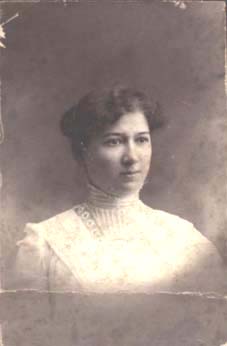 |
|
| Fleury Colon's father, François Henri Colon. | Fleury Colon's mother, Sylvie-Marie Piroudette. |
In marked contrast to his father, Colon's mother, Sylvie-Marie Piroudette, was a little-known sculptor and a poet who preferred solitude to the extroversions of her husband. As a young girl, she had recovered from a severe bout with tuberculosis, though it appears to have left her somewhat scarred physically and mentally. Her physical health was somewhat fragile, but this affliction, played out in the popular treatments of the day, may have also provoked a degree of mental instability. Colon himself, in a rare moment of direct openness, wrote, "She seemed always to teeter on the precipice of an abyss, and would spend hours locked in her bedroom."
It appears Colon's mother suffered from mental afflictions equivalent to an obsessive-compulsive disorder and what we now call a bi-polar disorder, and it's most likely this influenced her preference for isolation. A "condition" of some sort was embarrassingly mentioned in a notarized marriage license that Sylvie-Marie shamefully mentions in letters to her extended family, but regardless of the stigma, it's fairly certain she received little or no medical treatment for these mental disorders. Her devotion to the Catholic Church may have assuaged her condition, but only as much as it complicated matters. Her mental afflictions combined with her strict devotion to Catholic ideologies created a mysterious mother figure for the young Fleury Colon.
In peculiar fits of duress, Sylvie-Marie would wander the house, touching random objects while simultaneously spewing forth a litany of rapid, but barely audible prayers related to each object she was touching. Quite frequently she would invoke the saints and their splendorous works; but her schooling at the local Art Academy included Greek mythology, and thus in her transfixed state, she would also invoke the Greek pantheon of Mt. Olympus, and their equally splendorous works. Her bizarre "trances" seemed bewildering and yet "magical" to the young Colon.
The influence of this childhood environment becomes only too apparent in Colon's adult life, especially during Colon's later slide into madness.
"(John Camdus) Jones sent me to find out about the animal spaceship, namely, if it was real. I never expected anything like him (Colon). Jones said he was the other operative, but he seemed more like a crazed Jesuit. At dinner the first night, he read to us from a notebook. He'd whip through lines in a hoarse, rapid-fire whisper. He would often pause and wait for everyone to clap or clang their silverware. It was more like an incantation, though he called it poetry, and not surprisingly, it had a soothing effect. It was like a sedative. It was strange, no matter how you looked at it. And the adventure, as a whole, turned out to be one of my strangest assignments in the GDL (Gemini Defense League)."
--Nik Compton; GDL Representative, in a 1978 interview, recalling memories of Fleury Colon at the commune north of Montréal.
It's also apparent that Colon's mother exercised a certain amount of unintended indifference toward her son, perhaps because of her maladies. This indifference was more than likely complicated by her husband's absence from the household. Ascertaining the degree of Francois' neglect due to the business and his political activities is difficult, but it's certain that his distance affected the family. As a result, the young Colon was in constant search of his mother's approval, and appeared to be in competition with his brother Adam for her attention. From coherent passages of the CSAC Letters, one can gather that Fleury was not only haunted by the marked contrast of his parents, but by the phenomenology of his existence as a twin. Sorting through Colon's formative past, however, is not easy given his reticence to discuss his childhood.
"Eventually the conversation turned to family ... I asked him if Fleury was his given name, and that it had the ring of a nickname. My acknowledgment of his former name, a name I had overheard earlier, broke a barrier. He grew quiet suddenly and refused further inquiry. I thought, how odd--to be so lively and charismatic, and then suddenly, dark clouds. I changed the subject uncomfortably. Later that evening, someone at the commune told me his dark mood regarding his names had something to do with his brother Adam, his Father, and vague intonations of political intrigue and espionage. It was suggested I avoid raising the subject again, for I was lucky to see only his storm clouds and not the thunder and lightning."
--Guy Bouché, Aviator; in a recorded interview from 1986, recalling his brief stay in the commune.
Despite the estranged, dysfunctional nature of the Colons, family excursions to the coast of Normandy during Fleury's childhood were regular. The success of the family business allowed for small luxuries such as these trips. As in the case of Colon's mother, it was not uncommon for doctors to prescribe summer retreats at sea or countryside spas for recovering tuberculosis victims. With or without Francois, these trips may have also helped Sylvie-Marie mediate the symptoms of her delicate mental state.
Fleury's childhood excursions to Normandy were fraught with only minor psychological drama. Recalling these vacations by the sea, Fleury wrote, "After a morning swim, I would crawl out of the ocean and spend my mornings in the cool shade of the garden. In the afternoon, I would run through the nearby forest, sometimes in my underwear, occasionally attacking my brother from hiding places in the dense foliage along the paths."
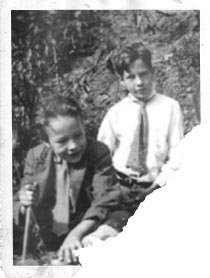
"Fleury"
and Adam in the garden adjacent to the Colon family's spa in Normandy.
3. AN INTERDISCIPLINARY EDUCATION & ANARCHICAL LOVE
Details from surviving family correspondence, suggest that the young Colon read prolifically during his twenties and filled notebooks with derivative, symbolist-inspired poems that were never published. By his own accounts, he sketched with proliferating abandon while his Mother's gift of an easel and canvas stared blankly at him from across his bedroom for five years straight.
"He (Fleury) blushes at the mention of a girl's name, but prefers books, mathematics, and drawings to the dance halls," states a letter addressed to Sylvie-Marie from her sister, Fleury's Aunt Charlotte. "Aren't you concerned?" From this detail alone, coupled with the fact that the names of girlfriends from this period are never mentioned, it appears that Fleury was not totally disinterested, but instead, shy of the opposite sex. His brother Adam appeared to be quite the opposite of Fleury, which only heightened the competition for their mother's attention, and thus their estrangement.
Already an avid model airplane enthusiast since his early youth, it appears Fleury's imagination as a young adult was more visibly impressed with Charles Lindbergh's solo-flight across the Atlantic Ocean in 1927. For a brief while thereafter, he considered joining the French Air Force; but his mother stepped out from one of her numerous "trances" long enough to talk him out of enlisting. Eventually, he enrolled in the Rouen Academy of Science in 1928 to pursue an interest in physics and general science, but dropped out after a year and returned to the family business in Rouen.
After this brief taste of independence from the family, it was clear that Fleury began to harbor an intense disdain for helping his father with the family business. Although he was taught the "ways of metal" in the hopes that he would eventually assist in running the atelier for his aging father, it was Adam who excelled in the business. Fleury reluctantly submitted to occasional duties in the atelier, writing that he "detested the smell and the darkness, feared the heat of the metal; and grew weary of my father's silent, watchful eyes." When visitors would come, he would slip through his "father's greasy hands"--a possible allusion to his Francois' political activities--and escape to the park with books, paper, and pencil.
In 1934, the pensive 29-year-old enrolled at the L'École de l'Architecture in Paris, which included requirements in structural engineering. It seemed to be a comfortable union of his interest in math, science, and art. He was not particularly inclined toward forced study, but with little effort, he was more than adequate in meeting the school's requirements for an education. Hence, he earned a reputation with the faculty as a "promising student, though he seemed to be in desperate want of a muse," according to George-Luc Generet, one of his former professors.
While vacationing with his family in 1938 at their spa-retreat in Normandy, the "quiet young man from Rouen" met and fell in love with the anarchist poet Margaruite Demain. Daytrips to Normandy became more frequent. Colon was fond of their late night discussions and their late evening walks through the local gardens and parks. Almost immediately, there was a noticeable increase in the young Fleury's confidence. Their relationship produced an outpouring of letters, most of which are lost; however, the letters that did survive suggest that Margaruite's influence--the fusion of politics and art--would bloom much later, in particular, after Colon had relocated to the wilds of Canada.

Fleury
and Margaruite Demain, c. 1937.
In the time between his graduation (May 1938) and the official outbreak of World War II (September 1939), Fleury Colon--along with other promising architectural graduates from the L'École de l'Architecture--volunteered to assist in the final stages of building the Maginot Line, a seemingly impenetrable line of defense that intended to thwart possible German military aggression after the first World War. Stretching for miles along the French side of the German border, the complex fortifications were named after André Maginot, a French military and political figure whose oratory skills persuaded the French Parliament to fund the project.
The defensive labyrinth consisted of interconnected, underground bunkers along with heavy artillery and thick concrete walls. Its first intention was to deter any thought of German attack; but if they were attacked, the Maginot Line was designed to withstand the head-on assault of the Nazi war machine. When the Germans did invade France, the Nazi military commanders sidestepped the Maginot Line because it would have been too costly for them to take, especially if employing the out-dated military strategies of the First World War. During the period leading up to the Nazi invasion, however, there is little doubt that the Maginot Line contributed to France's false sense of security.
Given the breadth of the fortifications, it was essential to the French Army that the aspiring architects had a background in engineering for they oversaw the continual additions and modifications to the massive defense structure. Although there were plenty of excursions into surrounding forests and villages, the young architect-engineers were actually housed deep inside the cement fortifications. And according to the recollections of his Alsatian bunkmate, Gustave Perrier, Colon's half of the cramped cement quarters became a "disheveled mess of papers and books. His (Colon's) re-interpretations of 16th century engravings--mostly of the Rouen skyline--were plastered to the cement walls with American chewing gum."
After a year of service, the positions of the lowly paid architect-engineer-soldiers were open to extension; but after the German attack on Poland in September of 1939, the "gang of eight" architects felt obliged to stay on as their patriotic duty. Colon, somewhat grudgingly, obliged. The jovial camaraderie of life at "The Front" continued but was strained by their joint sense of impending doom.

Fleury
Colon, c. October 1939, along with other architectural graduates in the
forest surrounding the Maginot Line (second from left, first row).
Meanwhile, the exchange of letters between Margaruite and the lovesick Colon intensified, and a peculiar awakening transpired. In his forced isolation deep inside the earth, Colon's independent studies in architecture were taking root. Visions of his childhood Rouen, a city known for its hundreds of gothic spires, collided with the readily available images of the Maginot Line's heavy artillery cannons and the constant parade of rifles cradled upright on the shoulders of marching soldiers. One can only muse that the young Colon--perhaps homesick and certainly lovesick for Margaruite--was somehow blurring his childhood in Rouen with the recurring imagery of guns. Along with something else that's too obvious, but perhaps unmentionable herein, it's easy to detect the beginning of Colon's great obsession with the finial.
"... I see its (the finial's) shape everywhere. The guns, the cannons--a skyline of spires--as if I was in my Rouen again, but it is a nightmare. Sometimes at night, in my loneliness, I have clutched it in my own hands. I often wonder, my Dear M, what it would be like to be free of all these idiots praying for war, to be free of this earthly burrow, to be free of these black letters, to be free of this white paper--to be with you, completely. I imagine this, our unimagined liberation, with every breath."
--Fleury Colon, excerpt from a surviving letter to Margaruite Demain.
When news hit the line that the Germans had invaded France, general panic turned quickly to calm resolve. It was going to be a long, horrible war, much like World War I. Mistakenly, the French soldiers defending the Maginot Line thought the Germans would have to eventually attack the Line. While everyone prepared for the horrible wait, Colon was ordered to conduct an important mission into a local town. Basically forced to run an "errand" to stock up on baguettes, cheese, and wine for his superior officer, it's possible that Colon's aforementioned desire for liberation was appeased. According to Perrier, Colon never returned to his barracks.
What follows is mostly speculation. But in the mind of zealous Colon scholars, namely Michael Peters, speculation is further bloated with romantic embellishments. Again, the reports are as varied as they are outrageous. Some accounts say he was captured but escaped to Spain. Some accounts have him fighting beside Charles de Gaulle in the early months of the German invasion; some have him hiding in the chalk caves of Normandy. Others suggest he, along with Margaruite, was an active member of the French Resistance during the Occupation. Still other accounts suggest Colon escaped the mainland during the military evacuation of Dunkirk, and worked in a munitions factory outside of London. Or better yet, such utter nonsense that he served as a spy, occasionally crossing the channel for the Allies with information vital to the success of the Allied war effort.
Finally, however, there is the string of events that certain factions of the Lettristes, mainly Jean-Robert Champlain, have sited as Colon's "ideological downfall;" namely, the aforementioned accusation that Colon associated with the Vichy Government. These accusations are the only claims that have been verified with documentation, albeit shaky documentation: namely, a letter and a blueprint of an architectural proposal to design train station shelters in the form of finials.
Let me be clear. I try to temper rabid speculation with facts. None of these reports are proven, and so they remain pure speculation. No one knows, for example, what Colon really did during the war. No one knows how Colon's relationship with Margaruite ended. Claims have surfaced that he fathered a child with her, but like much of Colon's history, none of it can be verified.
Again, it's best to stick to the facts: During these turbulent years Margaruite completely vanished into the opaque haze of history; and Colon's own historical presence could be described as incredibly elusive during this time, but hardly vanishing. Given the wild and dramatic reports of his activities during the war, it seems likely that he participated, in some manner, toward the liberation of France; but again, the details are simply absent. At the end of Nazi occupation, however, it's certain that a mature, enigmatic Fleury Colon first reappears in Paris in the fall of 1944 as a figure with a growing reputation and charismatic mystique.
5. POST-WAR PARIS & AN AFFAIR WITH LETTRISM
Following the liberation of Paris and the end of the War, Paris suddenly woke "as if from a deep sleep," according to Gustave Perrier, who was reunited with Colon, his former Maginot bunkmate, in the fall of 1944. With so much devastation from Allied bombardment of Nazi positions in the areas surrounding Paris, it was painfully evident that architects would be in high demand for the post-war rebuilding efforts. The architectural field appeared wide open. Although "everything seemed new," according to Perrier, something within Colon's character had also changed.
In an interview, Perrier suggested "Colon was looking further for something." A darker side, or a "thinking side," appeared intermittently between "an exuberance that was drastic in contrast. One had the sense he was keeping a secret," Perrier attested. Colon spent the first couple of years of liberation moving aimlessly from job to job, increasingly frustrated by his inability to find work to complement his architectural aspirations.
Meanwhile, his obsession with the finial was spilling over "like a fountain." Perrier suggests that Colon was disinterested in the advances of a new love interest, the architect Jeanne Goby. This was more than likely out of respect and a tacit, residual pain regarding Margaruite. Perrier seems to have been privy to what might have happened to Margaruite; but with Perrier's death in 1989, it will most likely be impossible to reveal the truth about Margaruite.
At any rate, Colon's passion for the finial seems to have benefited from his self-imposed celibacy. According to Perrier, Colon's desk lamp was visible at all hours of the night from the window of his six-floor walk-up in the 14th Arrondissement. As if making up for time lost to the war, it was a prolific period of musing and sketching; and Colon was in constant, furious motion with the idea of "his beloved finial."
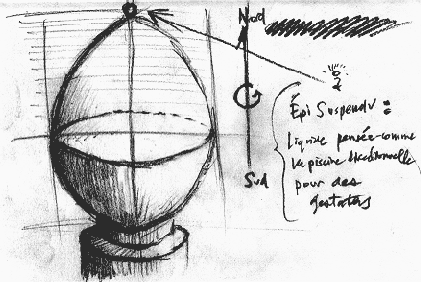
An early
finial "auto-sketch," c. 1946-1947.
In the autumn of 1948, Colon stumbled across Isidore Isou's doctrines quite by accident. Jean-Robert Champlain, a middle-aged surrealist who had already converted to the new movement of Lettrism, was unknowingly seated at a table next to Colon in a small café. Eventually, Champlain overheard Colon, Perrier, and Goby discussing a "reductionist architectural project," which of course was Colon's finial.
In his journals, Champlain wrote, "I immediately introduced myself and Guy (Debord) to Colon and his friends." [This "Guy" was Guy Debord, an acquaintance of Champlain's who would eventually break with the Lettristes and form The Lettriste International and from there, various incarnations of the Situationist movement.] Around this time, both Champlain and Debord were under the spell of the one-man juggernaut--Isidore Isou--who was responsible for founding the Lettriste movement. After brief pleasantries were exchanged, Champlain invited the table of architects to join the growing circle of "Lettristes." To Colon's acute amazement, Champlain proceeded to divulge the mysteries of Lettrism long into the Parisian night.
The following period was marked by a theoretical, as well as conceptual, awakening in Colon that carried over into the architectural applications of his finial. Isou's ideas stated that there were two phases in art--both a period of expanding ("amplic") and of constricting ("chiseling"). This concept seemed to suit Colon's pre-existing theories regarding the finial. After all, Colon was already seeking to reduce all of French architecture to the finial, and his finial project was reinforced by these reductive concepts or "chiseling."
With these radical ideas, a new French architecture seemed possible, a new architecture that would leave behind the old. According to Colon, the new architecture would reveal the pre-existing, ultimate form that had been a part of great architecture all along: The Finial. In turn, Colon's assimilation of Lettriste thought into his finial project could be readily re-applied to Isou's statements that society was approaching the end of a "chiseling" phase and was on the verge of a new "amplic" phase in poetry. Likewise, Colon also perceived a new amplic phase for the finial, and architecture in general, although the finial's amplic characteristics were not fully developed.
It was clear that Colon was passionate about the Lettriste movement of "Le Chaton" (The Kitten), which was his pet name for the younger Isou. According to Perrier, the excitable Colon was devising blueprints and pondering both the necessary and available resources to create a revolutionary change in the architectural academy. Perrier also suggests that the unbridled limits of Lettrism encouraged Colon's formerly subdued eccentricity, not to mention new methods of formulating thoughts. This freedom seemed to unleash previously dormant verbal skills.
"Colon became a faucet of ideas when he would think out loud," Perrier said. "Sometimes he would throw around ideas--like his floating finial structures--with reckless abandon. These intellectual fits were both exhilarating and terrifying. Quite easily, he could send us into wild discussions about anything." But Colon's conceptual marriage with the tenets of Lettriste ideology lasted just under a year. What followed this amazing period is a tumultuous morass of accusations and a farrago of misstatements that is ultimately referred to as the infamous "café debate" between Isidore Isou, Jean-Robert Champlain, and Fleury Colon.
Late on a drunken evening in May of 1949, an intense discussion about the fate of architecture within Lettrism was heating up. The café was still crowded and the din of voices might account for some of the confusion surrounding what transpired. Colon claimed to have jokingly suggested--at some point in the discussion--that Isou was in the "amplic" or expanding phase of his ego. Champlain claimed he remarked in Isou's defense to counter Colon's verbal attack, but Colon responded yet again with a "chiseling" metaphor aimed at Champlain. Something happened in the exchange that will, more than likely, never be revealed. Consequently, fierce shouting erupted from the periphery of tables, and sides were chosen. Eventually, fists were clenched and punches thrown. Policemen had to remove Colon and Perrier.
Regardless of what was said that evening, there is a sudden break in the attitudes of both Colon and Champlain toward each other. By the summer of 1949, there was a derisive, irreparable chasm between the two. Champlain takes a sudden vindictive tone when addressing the subject of Colon; and Colon has stated point-blank that Champlain set out to destroy him personally, often referring to the debate's outcome as the dubious achievements of "Champlain and his henchmen." There are no official accounts of this debacle. No one has described Isou's reaction. No one has ever acknowledged these alleged statements by Colon; but the scandalous avant-garde drama did not end with the debate. It quickly turned even more mythical.
Possibly at Champlain's suggestion, the French authorities were involved. The French Bureau of Investigation was already conducting numerous searches for Nazi and Vichy sympathizers in an effort to cleanse the nation's tarnished, somewhat humiliated psyche. Although Champlain later recanted some of his original statements, it was too little too late. Judgment was passed hastily over Colon's alleged attempt to "collaborate" with the Vichy Government.
Whether it was Champlain or not, the "informer" had to be someone with detailed knowledge of Colon's personal history. The rhetorically stretched implication of guilt stemmed from Colon's "train station" blueprints, and more specifically, a letter from Colon addressed to a Vichy official regarding possible funding for these finial-shaped train station shelters. The Vichy official, of course, had quickly denied funding for the project, but the letter and blueprints remained very real. It appears that the word "collaborate" had a very narrow definition in post-war France.
In hindsight, Colon could have very easily pleaded "guilty" to these weak charges with a defense that he was only acting with a vested interest in architecture, not to mention, the necessity of "making a living" in his chosen field. It was clear to anyone who knew him that he was utterly cloyed by political machinations, let alone inspired to "collaborate" with a government he held in contempt. If any punishment had been delivered, at worst, it would have been light.
Quite mysteriously, however, Colon completely vanished, which only confirmed his guilt in the eyes of the authorities. Perrier was briefly detained and Goby interrogated, but no one knew anything regarding Colon's whereabouts. Somehow in the process of the investigation, a file appeared corroborating Colon's unexplained disappearance from the French Army. Suddenly, Colon found himself to be the subject of an intense manhunt.
"I was subdued and cornered, imprisoned and confined like a captured animal, living in the chalk caves of Normandy, reduced to eating handouts of cold food from my brother's hand, not daring to step out from the cave's mouth into the illuminated night lest someone see me and turn me in. I was a dog. I had no fire. I was the dark beast. I was the text upon the cave's walls of chalk. And in the semi-darkness, I plotted my escape like an animal."
--Fleury Colon, excerpt from The CSAC Letters.
I don't want to brazenly suggest in the manner of Peters--the aforementioned, "liberal" Colon biographer--that Colon forthright hid in a literal "chalk" cave to elude the manhunt. But it does, however, seem likely if we note that this quoted passage above is an excerpt from one of Colon's early, more coherent CSAC Letters. Please note that I'm basing this "likelihood" on speculation supplanted by instinct and careful readings of these texts. It's equally possible that Colon's dramatic reference to chalk could be another one of his wild metaphors for paper, which is more characteristic of his later texts. How are we to be certain?
Therefore, almost all of this speculation is irrelevant. Once again, it should be noted that it's hard to affirm even the smallest detail of Colon's life based solely on his CSAC Letters. One has to take into account when these letters were written and the condition of their author. Given their sporadic narratives and spectacular derailments, the CSAC Letters should be admired as incredible works of art, perhaps even literature; but at the same time, scholars and enthusiasts should retain the basic premise that these texts are the diatribes of a madman. Although these letters have occasional couplings with reality, one should never take the CSAC Letters literally.
We are, however, certain of these solid facts: Colon escaped incarceration at the hands of the French authorities; and more than likely with some outside help, he was able to gain passage on an ocean-going vessel bound for a port on the East Coast of North America. About nine months later, Colon re-surfaced in Canada in the July of 1950. Although he had taken a new name, "Regarder Plus" (To Look Further), it was painfully obvious that it was the same finial-obsessed Fleury Colon that had so hastily left France.
With the benefit of hindsight, one can offer minor speculation that Colon's new name was as much an attempt to hide a former identity, as it was an affirmation to himself that he was starting over. All ties to Colon's personal past, intentionally or unintentionally, appear to have been severed. He doesn't really have any further contact with anything European at this point. And while the spectacle of controversy surrounding the legendary "café debate" and his "train station shelters" began its slow evaporation into Parisian folklore, history was being written anew in the New World.
Far from the self-aggrandizing climate of the Avant-Garde in post-war Paris, Colon befriended the American businessman Winthrop H. Frye in Montréal, Canada. It was this introduction that would seal the fate of the wayward Colon. Their friendship, according to all accounts, spans the length of the decade. It's essential we recognize both characters as central to accomplishing the spectacular undertaking, a project that will be revealed shortly herein. Without each other, this spectacular undertaking would have failed miserably, or perhaps, never been attempted.
At the time of their historic meeting, the 29-year-old Winthrop H. Frye was an upstart American entrepreneur in the very unspectacular field of scrap metal recycling. However, Frye was making spectacular earnings. As a middleman between Canadian junkyards and American steel companies, Frye would purchase automobile frames from the junkyards of Southeastern Canada and the Northeastern United States, and in turn, would undersell the recycled metal to various steel corporations under his "recycling collective." It was a lucrative business, not to mention environmentally ahead of its time; but his business would prove extremely useful toward an end he would have never envisioned.
[Enter Fleury Colon.] After literally colliding in the small Montréal pub, Colon and Frye made apologetic small talk; but when the conversation turned to the struggle between form and function, both of them soon discovered they shared many interests. Frye, who is still living, has attested that during the course of the historic evening, "large quantities (of alcohol) were divested and consumed." In record time, Frye apparently fell under the influence of Colon's passion, exuberance, and his "righteous marketing strategies."
As soon as the following morning, Frye recalled, "I stepped over Plus (Colon), who was sleeping on my motel floor, and went to the lobby for coffee. I began dialing up all of my associates in the grand effort of financing Regarder's (Colon's) visionary city. I often thought how easy it would be to regret that move, but I can't entertain even ten seconds of remorse. I wouldn't change a minute, even despite his (Colon's) later obstinacies. All along, the project had a shimmering allure. There were some truly great moments where I don't think I have ever been happier. It really was a literal utopia, and his make-believe skyline pulled me, passionately, into its invisible arms."
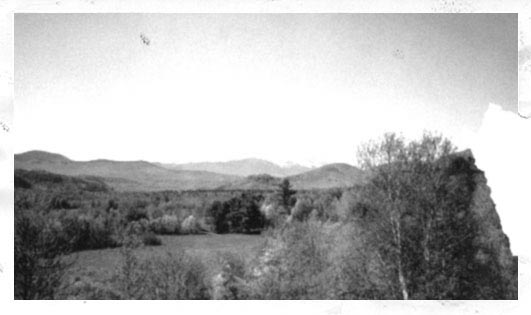
Site of Fleury
Colon's artistic commune, north of Montréal, c. 1951.
With some additional financing, Frye was able to secure 1,000 acres of somewhat rugged, untamed land. Here in the Canadian wilderness, roughly 120 miles north of Montréal, the mental and physical foundation was laid for one of the most stunning yet overlooked architectural achievements of the 20th century. It was a forest, basically; but in five short years, a small plot of this forest would undergo an amazing transformation, a transformation that would finally make Colon's visionary concept of the finial a reality.
Over the next year, word of the project leaked out into various arteries of the community, and eventually, found its way into unique circles across the continent. The project must have certainly met with skepticism and disbelief; but despite the undertaking's unbelievable qualities, it managed to raise the interest of a select few that did not immediately dismiss it. Somehow, 65 people seemed to magically appear in the forest Frye had purchased. As they convened in an obscure meadow in the spring of 1951, not surprisingly, Colon was the first to greet them. These artists, thinkers, poets, musicians, workers, artisans, and the general influx of curious intellectual vagabonds supplied the manpower for the newly founded "artistic commune."
"God, the sun was merciless the first summer (1951). But there was an unbelievable optimism, not to mention, a giddy satisfaction knowing that all our work was for this amazing utopian idea. I literally watched sweat fall from our chins and elbows into the grass and soil of the meadow. Regarder (Colon) usually worked at an outdoor desk in the shade, which was near his tent at the edge of the woods. He and Frye would frequently roll up their sleeves and help out. They'd bark out commands with huge, pleased grins on their faces. Sometimes, Regarder (Colon) would grow furious because he did not want us to stop; but his tantrums were brief. Eventually, night would come, and everything would cool off up in the mountains. As you can imagine, the nights were outrageous.
--Paula Cooke, commune member, recorded interview 1991.
With Frye's financial weight and his numerous connections to the scrap metal industry, the commune had ample material--recycled scrap metal--from which the workers of the commune began to assemble Colon's visionary city of finials. Colon oversaw the construction of a forge that ultimately shaped the raw material to his specifications. A modern, lead-free pewter, comprised of a 90% tin alloy, composed a large amount of the recycled scrap metal.
Ironically, Colon was working with pewter again and employing skills he had grudgingly learned, in his Father's atelier. It was no less ironic that he was successfully combining politics, viz. the anarchical principles of utopia with metallurgy, which was a combination that his father had never combined though he possessed an interest and familiarity with both. Regardless of Colon's personal sense of the struggle, the workers under Colon's leadership put forth a "magnificent effort" and "a utopian city emerged from under the canopy of conifers," according to Frye.
Colon's unique architectural structure, the Max Épi Maison (MÉM), can only be compared to R. Buckminster Fuller's Dymaxion Deployment Unit in that both structures share the fundamental principle of "working with nature" as opposed to struggling against it. Each MÉM served a unique function within the utopian vision and was specifically designed by Colon with these functions in mind. For example, each MÉM possessed advanced, non-electrical systems of plumbing, heating, and cooling. Primitive solar panels and rechargeable batteries, supplemented by wood stoves in both the communal kitchen and the pottery kiln, supplied the necessary energy for electric light and for supplemental heat in the winter.
While the project of assembling the MÉMs continued at a rapid pace, the commune members also found time to draft a declaration that abolished any notion of central authority. By 1952, portions of the meadow and the adjacent forest were turned over to a horticultural committee that aimed to retain its independence from modern technologies. Domesticated animals were introduced in 1954, but with the exception of a few chickens, traditional farming and animal husbandry were quickly forsaken. There was simply too much success with traditional fruit and vegetable stocks combined with indigenous plant and animal life to bother with the extra work.
Over the five-year period from 1952 to 1956, the commune erected a small village of these finial-shaped structures. The MÉMs stood at least 25 feet tall; and due to the makeup and consistency of the pewter, each MÉM possessed a luster of dull, bluish silver, which enhanced their futuristic utopian aura. By 1955, no less than 16 spired-MÉMs rose above the treetops on the edge of the meadow, a sight that to the occasional hiker must have certainly raised the question of whether or not they were still standing on the North American continent.
"I remember the guide leading me up this path to the top of a ridge. I looked out, and my jaw dropped. I thought I was looking at some Russian tsar's summer retreat, or perhaps, a strange suburb of Prague. It was breathtaking."
--Nik Compton; GDL Representative, recalling his first glimpse of the Montréal commune in a 1978 interview.
Some visitors knew exactly where they were standing, but nonetheless, confused by the sight of the MÉMs, felt compelled to question reality.
"It was very much like a movie from Hollywood. Like a cowboy, there before me in the valley, a cluster of teepees. But it was not in a book for children. It was real. Until my curiosity ate at me and said you must go, go, go, I was afraid of the future. "
--Guy Bouché, Aviator; in a recorded interview from 1986, recalling his stay in the commune.
With his architectural and engineering ambitions appeased by the fall of 1956, construction slowed and the commune shifted toward horticultural pursuits and commune maintenance for the simple fact that all of the major work had been completed. The physical realization of the finial was nothing less than a triumph. But like many of his fellow commune members, Colon had an increasing amount of free time on his hands. As each commune member pursued activities in individual fields of interest, the unlikely idea of leisure provoked an unexpected reaction in Colon.
Ever since his arrival in the Canadian forest, he had been admiring the stars. Miles from the disruptive lights of a major city, the night skies above the commune were dark, figuratively; but literally, the night sky was an ocean of stars shimmering above his finial paradise. Paula Cooke recalled that Colon would frequently stay out all night observing the sky when weather would permit, sometimes drawing or taking notes by sidereal light. "He'd sprawl out on a blanket, even in December," Cooke explained. "He didn't mind the cold so much, but he started to complain about having a pain in the neck." Soon enough, MÉM 3, his studio and living quarters, was fitted with a large telescope.
A mere six months later, a strange visitor to the commune provoked a reawakening of Colon's youthful fascination with aviation. Canadian aviator and stuntman Guy Bouché became a temporary resident of the commune in June of 1957 for about five months when he was forced to crash land his bi-plane in another meadow just beyond the forest. Colon and Frye took an immediate liking to Bouché and agreed to help him finance the restoration of his bi-plane. Bouché recalled being struck, not only by Colon's quirkiness, but by his inquisitive scientific nature regarding mechanical operations.
"Regarder (Colon)--[laughing...]--the drooling astronomiste would stand transfixed with his eye upon the hole of his big--as I teased him--magnifying glass. All the while, he'd chant all the facts and laws about the stars like it was a prayer. It was very very nice music to hear. He must have read a lot of books on the planets and stars. He was crazy, but a good crazy. Some of the time, he would tease me back by calling me 'Unlucky Lindy.' But most of the time, he asked me lots of questions, too many questions, about the nature of my airplane. He seemed sort of possessed with the idea of flight."
--Guy Bouché, Aviator; in a recorded interview from 1986, recalling his stay in the commune.
Just as Bouché was preparing to leave the commune, something happened, which imploded Colon's pre-existing fixation with stars and his rekindled appreciation for aviation and the idea of air travel. On October 4, 1957, the Soviet Union sent Sputnik into a 98-minute, elliptical orbit of the earth. Colon was certain he had spied the 180 lb., football-sized satellite streaking above the dark silhouettes of the Canadian treetops. Sputnik not only signaled the start of the space age, but it marked another beginning for Fleury Colon.
After the Sputnik sighting, Fleury Colon was reborn once again with an ambitious fervor for what would become another application of his "beloved finial." Hindsight suggests that Colon's new beginning was more like the end; but regardless of this retrospective glance, Colon's finial obsession was re-incorporated, re-invented, and quickly projected into his fixation with stars and the idea of air travel. While the "space race" between the United States and the Soviet Union escalated, Colon independently pursued an avant-garde foray into aeronautics and space travel that remains unprecedented. The results were as absurd as they were spectacular.
Almost immediately, Colon jumped into the immensity of research and preparations, not to mention the sheer contemplation of the unknown. All through the winter of 1957-58, the electric lamps in his studio observatory burned late into the Canadian night. He produced close to 3,000 drawings and blueprints of finial-shaped rockets and missiles; and with only peripheral assistance, conducted exhaustive research on everything from the historical precedents of V-2 rockets and weather balloons to all known systems of propulsion and fuel.
His ability to merge disciplines was phenomenal. He entertained the idea of manned space flight, and explored possible methods of life support systems in outer space. But the constant regimen of both scientific research and the creation of the blueprints consumed him; and in the process, the first noticeable symptoms of what must have been severe sleep deprivation began to manifest themselves in Colon's already peculiar nature.
Cryptic mathematical equations and unconventional--near poetic--texts adorned the margins of his drawings and blueprints. In some respects, the surviving sketches and blueprints appear crude, almost comic book-like, and yet they were rendered with an endearing authenticity and a painstaking adherence to scientific detail. But the intense acceleration of his ambition and passion exacerbated his already peculiar demeanor, according to Paula Cooke. It seems obvious to us now that Colon was somehow destined to burn in his own conflagration.
Cooke also stated that as early as November of 1957, Colon began to mention the idea of an "Animal Spaceship" in his notes and conversations; and by late 1958, this idea seems to have been "embedded in his psyche." A sort of synthesis of concepts, the "Animal Spaceship" was on one level a metaphor for the earth, and at the same time, it was Colon's very vivid concept of a spaceship capable of leaving the earth's gravitational pull. Of course, animals--namely human animals--would pilot this vessel. Commune members began to jokingly refer to Colon's Animal Spaceship as "The Ark."
Giggling among the commune members turned to "dumbstruck awe," as Frye put it, when news reached the commune that the Russians had successfully sent a dog out into space and back. Unlike the "successful" Sputnik 2 mission that resulted in the dog-astronaut Laika's sacrificial death, Sputnik 3 was able to orbit the earth and re-enter the atmosphere without the animal losing its life, which was a first. Colon was elated, and began to increase efforts to complete the finial aeronautics project as if the commune were the third contestant in the "space race."
Rumors flourished that the metal forge would be in action for the first time since MÉM 16--the last MÉM--was erected; but this time, they would be building a spaceship. It seems absolutely absurd; but a tacit optimism inflated the commune, not to mention, solidified a heightened appreciation for their eccentric figurehead. Outside the commune, however, dissemination of Colon's latest undertaking was rebuffed with the usual skepticism. Just as reports of his finial paradise were dismissed, likewise Colon's "Animal Spaceship" appeared even more ludicrous. Despite the marginalization of Colon's latest pursuit, news of its existence--however trivialized--managed to leak out into various open-minded communities and avant-garde organizations of the "real world."
"When I mentioned the rumors of his plans for an Animal Spaceship, he (Colon) suddenly dropped to all fours and began gnawing at these stacks of papers standing in piles across the cement floor of his pewter MÉM. He sniffed one pile of papers in particular, and with a strange look on his face, he drew back and barked, convincingly. Then, if you can believe it, balanced precariously as he was, he unbuckled his drawers, hoisted his leg in emulation of a dog, and micturated upon his labors. Luckily, only the bottom papers, the rough drafts, were soiled by this loose behavior. The blueprints were breathtaking."
--Nik Compton; GDL Representative, recalling a 1960 confrontation with Colon in a 1978 interview.
Despite his exhausted mental and physical condition, Colon's uncanny ability to walk the line of believability was still intact. Ultimately, it's this trait that makes him so unique and fascinating to historians like myself. Colon's typically intense confidence, albeit as warped as it was unshaken, fed his puritanical belief that the data he was gathering--that all the hard work--would lead to the project's realization. In his own words: "We have built the city, why not something greater?"
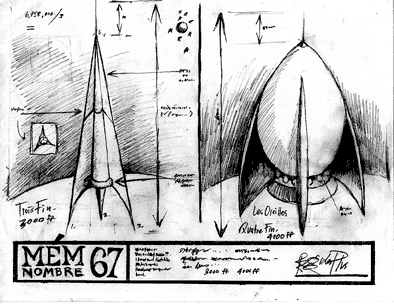
Fleury
Colon (Regarder Plus); Finial Fuselage Blueprint "MÉM: Nombre 942,"
c. 1958; courtesy Knowlton Estate (Colon Archive).
Several "finial fuselage" test models were chosen from the accumulating archive of blueprints. The forge was re-opened. Colon began to see the peaceful meadow adjacent to the commune with new eyes. Accordingly, plans for a hangar and a launch pad were drawn up. Meanwhile, test final fuselage models were developed from scraps of pewter that were leftover from the construction of the MÉMs.
His continuing research included all manner of scientific, albeit near medieval, studies on the aerodynamics of the finial; but as the test models neared completion, the project wavered in uncertainty. It was a simple matter: The commune's facilities to test even small-scale models of the finial spaceships were horribly insufficient. According to Frye, Colon felt strongly that building a wind tunnel was feasible, but the estimated amount of time it would take, given the commune's somewhat depleted resources, would put Colon unforgivably behind on the optimistic timetable.
Remember, Frye had already sunk a significant amount of his financial earnings into the commune. Both of them understood that despite the stunning success of the finial commune, it would be too costly to create their own wind tunnels. With over two years of relentless research and preparations behind him, Colon petitioned the Canadian Space and Aeronautics Commission (CSAC) in August of 1960 for access to their wind tunnels.
9. THE MADNESS OF FLEURY COLON
This is the juncture where most scholars would suggest Colon lost even himself. I have to agree. The architect cum rocket scientist grew impatient when CSAC ignored the first letter. Within two weeks, a second letter was sent, and then a third, and then a fourth, et cetera. CSAC never responded. Colon tried calling the CSAC offices several times from a payphone in the nearest town, but was left indefinitely on hold each time. Blaming their silence on bureaucratic indifference, Colon increased the string of letters.
It's these letters--the famed "CSAC Letters"--that are so frequently referenced in the oeuvre of Fleury Colon. As Peters suggests, the CSAC Letters are rife with autobiographical information, which is true to a certain degree; but it's also apparent these letters were authored by a man slipping into the crevice of insanity. Again, one should avoid lending them undue biographical power with whimsical interpretations.
Begun in August of 1960, these letters did not stop until late 1963. Over 900 letters were addressed to CSAC, but less than half of these were actually sent. A large number of the letters disappeared in the mails, and from the remaining half only 26 letters are known to still exist. The letters were composed, first with a manual typewriter. Later, as Colon continued his decline, they were handwritten. Fortunately for the sake of Colon scholars and Avant-Garde enthusiasts, the letters were duplicated with carbon paper. If not for the carbon paper, even the 26 known letters would have been lost.
Letter writing became a daily chore like splitting wood, weeding the garden, or brushing one's teeth. By all previous standards, it was still a very productive time for Colon; but the handwriting, and likewise the content of the letters quickly deteriorated into unexplored realms of visual images, prose, and poetry. By 1962, one questions if these works are still technically letters for they are too illegible and incoherent to be defined as such.
Eventually, Colon's letters began to resemble bizarre grocery lists and crude sketches. It shares more with children's art than with great literature, but there is something absolutely intoxicating about his work when it's put into context of his time and place in history. With little or no intended meaning, the "CSAC Letters" appear to be hastily scribbled onto scraps of paper that were probably intended for inclusion in a more official letter. By 1963, these indecipherable, poetic fragments littered the floor of his MÉM studio.
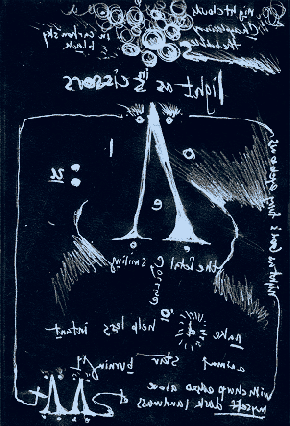
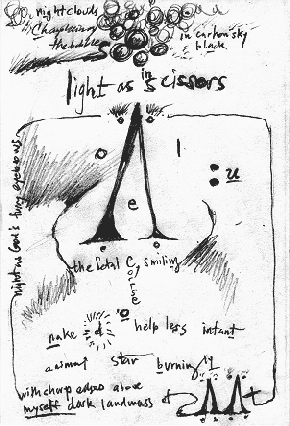
Left: Fleury
Colon (Regarder Plus); Carbon paper fragment of an unidentified CSAC Letter c. 1963;
courtesy Knowlton Estate (Colon Archive). Right: Computer-enhanced image to show how the actual letter would have appeared.
In the three-year breadth that Colon composed the CSAC Letters, the aging visionary's diminishing mental faculties seemed to mirror the "Letters" deterioration into poetic nonsense. According to Winthrop H. Frye, Colon's aeronautic obsession, culminating in the first CSAC Letter, likewise signaled, perhaps even foreshadowed, the dissolution of the commune.
"It was like Regarder (Colon) wanted to leave everything behind, yet again," Frye mused. "After all our hard work, it was all too much, and all too fast." Frye stood by and watched with a feeling of helplessness as Colon continued his remarkable somersaults into madness. Most regrettably, there is something to be said for the thrills of a historian. With the arc of Colon's existence before me, there is a voyeuristic thrill to watching Colon's erosion.
Frye along with other commune members noted increasingly drastic mood swings in Colon's demeanor. For one, Colon seemed prone to darker fits of rage. Secondly, Colon's strange behavior, not unlike the dog-like behavior noted earlier by Nik Compton, was increasing and growing more severe. Third, the duration of these abnormal states, which were usually related to animal behavior, progressively lengthened. This in itself is worth closer inspection because it appears to be related to his concepts of the "Animal Spaceship;" but again, the veil of history limits our conclusions. We are certain, however, that all of Colon's symptoms coincide and may account for the increasing illegibility of his CSAC Letters.
By late 1963, Colon's faculties were severely crippled by his inability to communicate, despite the efforts of the commune to rectify their leader's strange affliction. On occasion, Colon would disappear into the woods for days on end. "No one was certain where he (Colon) would find sustenance or shelter during these disappearances," explained Cooke. "We worried about him, but he would refuse doctors." Commune members would often leave bowls of food on their MÉM doorsteps. Several times, he was found naked and shivering, inside a dog house next to MÉM 3.
Then, in one of his intermittent spells of coherency in late November of 1963, Colon "expelled" Frye from the "Finial Utopia." Frye was already forced to spend increasing lengths of time away from the commune in pursuit of business interests to support the failing commune. As Frye explained it, "Enough was enough. After waiting patiently for years, I was bankrupt--mentally and physically. I hated to see him suffering, but it cloyed me that he refused any help. Anyway, I went to tell him I was leaving, for good... and amidst his absurd naying and damned whinnying, he bellows at me that I'm expelled. I said, 'Great.' Then he suddenly turns about and runs headlong into the forest screaming obscenities in French. It was strange, an upsetting farewell. I didn't see him again."
While all accounts confirm that he was failing, Fleury Colon seems to have turned inward, perhaps to combat the dementia that continued to unravel his being. His obsessive nature was reduced to a sole fixation with the night sky. When he wasn't running wild in the forest, he would sequester himself in MÉM 3 and sleep into the late afternoon. At night, Colon would religiously fix his telescope upon the clear winter skies for hours on end.
Peters theorizes that the CSAC Letters were possibly Colon's notes on celestial observations; but this is, once again, dangerous historical speculation. Like many of his unprofessional theories, Peters' elaborate interpretations lead to even more elaborate interpretations. Where does it end? How can Colon's genius--which includes all of his stunning achievements--be so patronized by Peters to suggest that Colon was infallible and somehow, despite the madness, still in control of his faculties?
With his imaginative skills as an interpreter, Peters offers another theory that a newcomer appeared in the commune around this time, which contradicts reports that the commune's population had been steadily thinning since late 1960. Peters' "Guest Theory" includes the presence of Jean-Robert Champlain, which is utterly ridiculous and built upon embarrassingly loose foundations of interpretation. There is absolutely nothing to prove these "theories," and thus they remain "theories." It is important to stick to what is known.
We can be certain of this: Fleury Colon died, quite spectacularly. Spring had already settled its gracious mood upon southern Canada. It was still colder in the shade of the forest, but the meadow of the commune was in full-bloom. It was May 21, 1964, and with the obligatory warm front rolling in, Colon was "renewed with a cognizant vigor," according to his now steadfast companion Paula Cooke. "He (Colon) was in excellent spirits. Everyone was enjoying the weather and sunshine, and so I decided to go into the nearest town, which was 45 miles away, to run some errands. I shouldn't have left. I still regret that."
Frye, who was already living in exile from the "Finial Utopia," received second hand reports, much like Cooke's, roughly as follows: While Cooke was off running her errands, the 58-year-old Colon decided that the telescope lens of his MÉM 3 observatory needed cleaning. A small crowd of alarmed commune members watched him ascend the vertical cylinder of his finial masterpiece. Some tried to convince him to come down, but Colon ignored their pleas. When he reached the exposed lens of his telescope atop the 25-foot MÉM, it was necessary for him to reach up and out with his cleaning rag. This movement required him to lean backwards. A rope or a pulley in the scaffolding system suddenly snapped. Colon fell backwards, landing directly on a doghouse, and was brutally impaled on its finial-shaped roof.
11. THE LEGACY OF FLEURY COLON
The dispersal of the commune's members and the physical disappearance of the commune itself remains somewhat of an unsolved mystery. After Colon's death, the commune unofficially disbanded. Vegetation quickly reclaimed the grounds, and the pewter MÉMs fell into disrepair. Hikers still reported seeing silver-blue spires rising out of the treetops. But when a road built for logging trucks was cut through that part of the forest in 1972, evidence of the 16 MÉMs seems to have vanished. No one knows where.
Paula Cooke has accused Winthrop Frye of re-selling the metal from the MÉMs to offset the lingering debt from the whole undertaking. Frye dismissed these accusations, although he readily agreed that the commune had incurred a "large debt" though he claims to have single-handedly eliminated this by re-selling the land in the late 1960s.
The loss of the finial skyline is too horrific to imagine; but perhaps the second-most tragic result of the commune's evaporation is the destruction of nearly all of Colon's works in a horrible fire that left MÉM 3 a blackened scrap of metal in the summer of 1964. To our benefit, Cooke was able to rescue small portions of the archival material at great risk to her own safety.
It's this rescued material that comprised the core of Thomas Knowlton's scholarship on Colon. Donated by Cooke, the famed "CSAC Letters" and related materials provided the foundation for Knowlton's book: Regarder Plus: The CSAC Letters. Knowlton also purchased important archival material from the Colon-scholar Jean-Jacques Cory, who had previously purchased material from Gustave Perrier. It was Knowlton's intention to open a small museum and gift shop near the site of the original finial commune; but with Knowlton's recent death, plans for the Fleury Colon Archive & Museum have dissipated. Instead, the Knowlton Estate will likely donate the archival Colon materials to the special collections department of a deserving university library.
In addition to his surviving works, brief note must be made of Fleury Colon's conceptual legacy. Colon is often associated with the idea of "Absenteeism" thanks to the efforts of a select handful of colleagues, commune associates, and avant-garde enthusiasts. According to avant-garde theorists, Colon's concept of "Absence" is validated by his resolution of the theoretical problem that followed him from his conceptual context in Lettrism to the Candadian forest--namely, the resolution of a new "amplic" phase for the finial.
The finial as a Spaceship is the realization of Colon's ideas of a new "amplic" phase for the finial, and in this sense, "amplic" is the idea of expansion--of movement out into the aether of space--and this idea is touched by the very idea of space travel in rocketships shaped like finials. A new "amplic" phase for the finial should also be recognized as a "departure" that simultaneously creates a notion of "Absence," manifested in the Animal Spaceship. It's astonishing to consider how close Colon came to the realization of his spaceship. It was only prescient decade off from the moon landings in 1969. It was like the MÉM s themselves were poised to take flight from the meadow of the finial commune.
There are scant references to the idea of "Absence" in his texts, but both its intended qualities as a concept and its relation to his "birth dialectic" are somehow intertwined with the mythology of his ultimate legacy: The utopian vision. Along with the unprecedented combination of disciplines--metallurgist, architect, engineer, draftsman, mathematician, and finally, rocket scientist, poet and artist--this idea of the utopian vision and "Absence" and are perhaps his greatest contributions. Despite the madness that eventually consumed him, Colon remains a visionary who transcended the limitations of modernity. There is no figure like Fleury Colon in the whole of the 20th century.
One last irony remains. Colon's concept of Absence also reflects the fate of the commune itself. As noted, the stunning, physical structures of the finial commune have inexplicably disappeared while the architectural achievements of Fleury Colon remain unrecognized. Unlike The Lost Colony of Roanoke, there were no mysterious texts carved into the trunks of the pine trees near where the commune once stood. Colon is buried somewhere in the meadow in an unmarked grave at the edge of the pine forest. Today, it's difficult to imagine a skyline of finials peeking out from the tops of these pine trees. The meadow on the edge of the forest is empty. One is not even sure if it's the exact meadow.